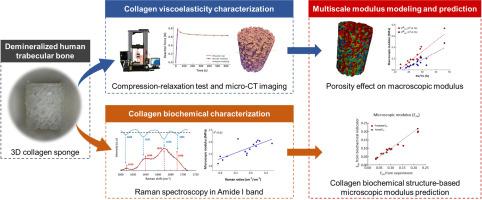脱矿人小梁骨粘弹性行为的多尺度建模
IF 9.4
1区 工程技术
Q1 ENGINEERING, MECHANICAL
International Journal of Mechanical Sciences
Pub Date : 2025-09-24
DOI:10.1016/j.ijmecsci.2025.110887
引用次数: 0
摘要
骨是一种由无机相和有机相组成的分层复合材料,无机相控制刚度和强度,有机相控制韧性和屈服后行为。有机相的力学特性,特别是在脱矿小梁骨中,仍然知之甚少,限制了对骨折机制和支架设计的认识。在这项研究中,我们使用综合方法,结合应力松弛测试、微有限元模拟和宏观和微观尺度的拉曼光谱,研究了人类脱矿小梁骨的时间依赖性粘弹性行为。量化多尺度平衡和瞬时模量,并与小梁微结构和胶原蛋白光谱标记相关联。我们的研究结果揭示了胶原完整性和微结构如何共同控制粘弹性行为,提供了组织组成和宏观力学性能之间的机制联系。这些发现不仅促进了对骨小梁中有机基质力学的基本理解,而且为设计复制原生生物力学和生化微环境的仿生支架建立了预测框架。本文章由计算机程序翻译,如有差异,请以英文原文为准。

Multiscale modeling of viscoelastic behavior in demineralized human trabecular bone
Bone is a hierarchical composite of inorganic and organic phases, with the former governing stiffness and strength, and the latter controlling toughness and post-yield behavior. The mechanical properties of the organic phase, particularly in demineralized trabecular bone, remain poorly understood, limiting insights into fracture mechanisms and scaffold design. In this study, we investigate the time-dependent viscoelastic behavior of human demineralized trabecular bone using an integrated approach combining stress-relaxation testing, micro-finite element simulations, and Raman spectroscopy at macro- and microscales. Multiscale equilibrium and instantaneous moduli were quantified and correlated with trabecular microarchitecture and collagen spectral markers. Our results reveal how collagen integrity and microarchitecture jointly govern viscoelastic behavior, providing a mechanistic link between tissue composition and macroscopic mechanical performance. These findings not only advance fundamental understanding of the organic matrix mechanics in trabecular bone but also establish a predictive framework for designing biomimetic scaffolds that replicate the native biomechanical and biochemical microenvironment.
求助全文
通过发布文献求助,成功后即可免费获取论文全文。
去求助
来源期刊

International Journal of Mechanical Sciences
工程技术-工程:机械
CiteScore
12.80
自引率
17.80%
发文量
769
审稿时长
19 days
期刊介绍:
The International Journal of Mechanical Sciences (IJMS) serves as a global platform for the publication and dissemination of original research that contributes to a deeper scientific understanding of the fundamental disciplines within mechanical, civil, and material engineering.
The primary focus of IJMS is to showcase innovative and ground-breaking work that utilizes analytical and computational modeling techniques, such as Finite Element Method (FEM), Boundary Element Method (BEM), and mesh-free methods, among others. These modeling methods are applied to diverse fields including rigid-body mechanics (e.g., dynamics, vibration, stability), structural mechanics, metal forming, advanced materials (e.g., metals, composites, cellular, smart) behavior and applications, impact mechanics, strain localization, and other nonlinear effects (e.g., large deflections, plasticity, fracture).
Additionally, IJMS covers the realms of fluid mechanics (both external and internal flows), tribology, thermodynamics, and materials processing. These subjects collectively form the core of the journal's content.
In summary, IJMS provides a prestigious platform for researchers to present their original contributions, shedding light on analytical and computational modeling methods in various areas of mechanical engineering, as well as exploring the behavior and application of advanced materials, fluid mechanics, thermodynamics, and materials processing.
 求助内容:
求助内容: 应助结果提醒方式:
应助结果提醒方式:


